|
The defense of San Francisco Bay was of paramount importance during World War II. Not only was there a large civilian population and interior agricultural industry to be protected, but there were major military and industrial complexes in the Bay Area that were prime targets for Japanese attack. Many of the troops and supplies for the Pacific theater passed through the bay and the Golden Gate on their way to the Pacific Theater. Military infrastructure in the area included Fort Mason, which was the port of embarkation for over a million soldiers during the war, and the Presidio, from which the defense of the Pacific Coast was run. Treasure Island and Alameda Naval Air Station were important naval bases. Liberty ships built by the hundreds at the Kaiser Shipyards in Richmond, California, were loaded with cargo, food, medical supplies, tanks, guns, and construction equipment at the ports of San Francisco and Oakland. Hunter's Point and Mare Island Navy shipyards made ships and landing craft used on the many amphibious landings during the war. The local shipyards also repaired and serviced many of the ships and submarines from the Pacific Theater. Port Chicago was a critical ammunition supply depot. All these vessels had to pass through the narrow Golden Gate Straits. To protect the crucial Golden Gate and Bay Area harbors, an integrated coastal defense system was constructed. This system of weapons, fire control, mines, nets, and men were all that kept the vital life line from San Francisco bay open to supply the men and women of the Pacific Theater. 
PARC, GGNRA This former World War II military post stands at the edge of the Pacific Ocean and was part of San Francisco's first line of defense against enemy attack. 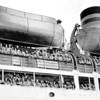
PARC, GGNRA San Francisco Port of Embarkation From the 1920s through World War II, the San Francisco Port of Embarkation played a critical role in the movement of supplies and troops to the Pacific. 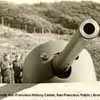
San Francisco Public Library San Francisco's harbor defenses relied on a complex system of guns, underwater mines, and antisubmarine nets. Central to the system were guns of many sizes, each with its own purpose. These guns were classified by the diameter of the projectiles they fired. 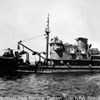
PARC, GGNRA If the big guns failed to stop an enemy vessel far offshore, the next line of defense was three minefields containing over 600 underwater mines outside the Golden Gate. An antisubmarine net located inside the Gate would prevent any submarine that penetrated the minefield from entering the bay. 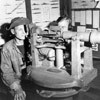
San Francisco Public Library Fire Control (Aiming the Guns) Fire control used a system of observation posts, plotting rooms, and command stations. Radar and listening devices were used to detect incoming aircraft, searchlights helped aim the guns at night, and observation planes flew out of Hamilton Airfield in Marin County. The Army and Navy coordinated the entire operation from the Harbor Defense Command Post at Fort Scott. 
California Military History Museum Seventeen "batteries" of about 125 soldiers each, manned the Harbor Defenses of San Francisco during the war. These highly trained men maintained and fired the guns, plotted ranges, and staffed the base end stations. Early in the war, they lived at the remote gun batteries and base end stations for weeks at a time. Moral often suffered as they tried to maintain a high state of readiness through long periods with little to do. 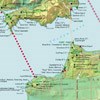
courtesy of Brian Chin |
Last updated: February 28, 2015
